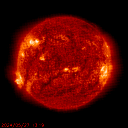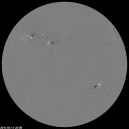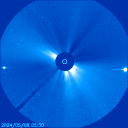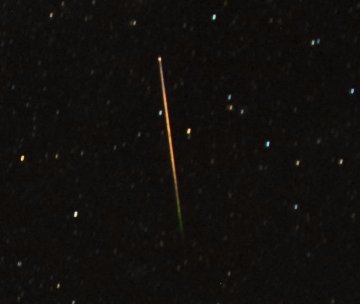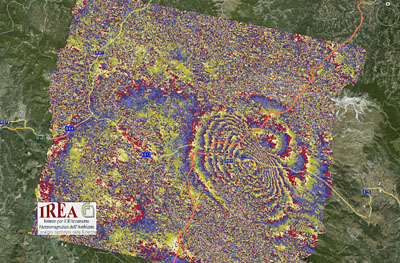
26 Nisan 2009 Pazar
:: ISS Gözlem Uyarısı.. Samsun, 27/04/2009 Pazartesi...
 Gözlem Konumu : Samsun ve Türkiye'nin büyük bir bölümü
Gözlem Konumu : Samsun ve Türkiye'nin büyük bir bölümüGeçiş Tarihi : 27/04/2009
Geçiş Saati : 03:57: ~ 04:01
Geçiş Max Parlaklığı : - 0.6
Veri Kalibrasyon tarihi (NASA J-TRACK kaynağı ile) : 26/04/2009 : 14:00
Yerel Geçiş Yörüngesi : Güney-Batı ~ Kuzey-Doğu , Max: 30 derece...
Tahminler, NORAD'ın kullanımına izin verdiği veriler ile kalibredir.
Hava Durumu : Samsun ve çevresi parçalı bulutlu
INOSCI Labs.
24 Nisan 2009 Cuma
:: Sanal Casuslar, Pentagon'un 300 Milyar dolarlık JSF Projesine erişmiş olabilir.



Bilgisayar Casusları, Pentagonun 300 Milyar $ değerindeki JSF (Joint Strike Fighter - Müşterek Saldırı Uçağı) projesine eriştiği düşünülüyor.
Benzer şekilde, Amerikan Hava Kuvvetlerinin Hava Trafik Kontrol Sistemine de erişim olduğu düşünülüyor.
JSF projesi ile ilgili olarak, Pentagon'dan birkaç terabaytlık veri çekildiği düşünülüyor.
Çekilen bu verilerin içeriğinde JSF ile ilgili tasarım ve elektronik sistemler hakkında bilgi içerdiği düşünülüyor.
Yetkililerin açıklamalarına göre çalındığı düşünülen bu bilgiler ile JSF uçaklarına karşı potansiyel tehlikeler oluşturulabileceği anlaşılıyor.
İlgili saldırının 6 ay önce gerçekleştiği düşünülüyor.
Ayrıca yetkililer saldırının Çin kaynaklı olduğu düşünüldüğü açıklanmış.
Çin Ordusunun Online Savaş Teknikleri üzerine çalıştığı biliniyor.
Çin'li yetkililer ise "bu düşünce soğuk savaş dönemi mantelitesidir" açıklamasında bulunmuş...
Bush Hükümeti Online Güvenik için birkaç yılda 17 Milyar $ para harcadığı ancak bunun yeterli olmadığı açıklanmış...

Joint Strike Fighter Projesi, diğer adı ile F-35 Lightning II, Pentagonun yeni nesi savaş uçağı konsepti. Bu konseptin son insanlı savaş uçağı konsepti olacağı düşünülüyor.
Lockheed Martin firmasının yürüttü projede, 7.5 Milyon satır Bilgisayar kodu kullanıldığını söyleniyor.
Sisteme sızma ile ilgili olarak Pentagon'dan askeri uzmanlar yüksek seviyede inceleme ile, Çin kaynaklı internet protokol (IP) adresler ile dijital ayak izlerinin izini sürmeye başlamış...
Not: JSF Projesi ortaklarından birisi de Türkiye'dir!
Kaynak: SANS Institute
Benzer şekilde, Amerikan Hava Kuvvetlerinin Hava Trafik Kontrol Sistemine de erişim olduğu düşünülüyor.
JSF projesi ile ilgili olarak, Pentagon'dan birkaç terabaytlık veri çekildiği düşünülüyor.
Çekilen bu verilerin içeriğinde JSF ile ilgili tasarım ve elektronik sistemler hakkında bilgi içerdiği düşünülüyor.
Yetkililerin açıklamalarına göre çalındığı düşünülen bu bilgiler ile JSF uçaklarına karşı potansiyel tehlikeler oluşturulabileceği anlaşılıyor.
İlgili saldırının 6 ay önce gerçekleştiği düşünülüyor.
Ayrıca yetkililer saldırının Çin kaynaklı olduğu düşünüldüğü açıklanmış.
Çin Ordusunun Online Savaş Teknikleri üzerine çalıştığı biliniyor.
Çin'li yetkililer ise "bu düşünce soğuk savaş dönemi mantelitesidir" açıklamasında bulunmuş...
Bush Hükümeti Online Güvenik için birkaç yılda 17 Milyar $ para harcadığı ancak bunun yeterli olmadığı açıklanmış...

Joint Strike Fighter Projesi, diğer adı ile F-35 Lightning II, Pentagonun yeni nesi savaş uçağı konsepti. Bu konseptin son insanlı savaş uçağı konsepti olacağı düşünülüyor.
Lockheed Martin firmasının yürüttü projede, 7.5 Milyon satır Bilgisayar kodu kullanıldığını söyleniyor.
Sisteme sızma ile ilgili olarak Pentagon'dan askeri uzmanlar yüksek seviyede inceleme ile, Çin kaynaklı internet protokol (IP) adresler ile dijital ayak izlerinin izini sürmeye başlamış...
Not: JSF Projesi ortaklarından birisi de Türkiye'dir!
Kaynak: SANS Institute
23 Nisan 2009 Perşembe
:: Base Jumping!..
22 Nisan 2009 Çarşamba
21 Nisan 2009 Salı
19 Nisan 2009 Pazar
:: Debian Etch'e SELinux...
:: Kepler'den ilk Işık... NASA

NASA'nın Kepler Uzay aracının çektiği ilk görüntü Dünyaya ulaştı...
Kepler, Dünya benzeri gezegenleri araştırmak amacı ile yörüngeye gönderildi...

http://kepler.nasa.gov/
Kaynak: NASA
Kepler, Dünya benzeri gezegenleri araştırmak amacı ile yörüngeye gönderildi...

http://kepler.nasa.gov/
Kaynak: NASA
18 Nisan 2009 Cumartesi
:: NASA, GOES-O Görevi...

NASA'nın meteroloji uydusu olan GOES-14 ile yer değiştirecek GOES-O, 12 Mayıs 2009'da fırlatılacak.
GOES-0'ın 5 yıl görev yapması planlanıyor.
Daha fazla bilgi: http://www.nasa.gov/mission_pages/GOES-O/main/

GOES-0'ın 5 yıl görev yapması planlanıyor.
Daha fazla bilgi: http://www.nasa.gov/mission_pages/GOES-O/main/

4 Nisan 2009 Cumartesi
:: ABD Hava Kuvvetlerinde "Sanal Uzay Komutanlığı"...

İnternetin yaygınlaşmasının oluşturduğu güvenlik ve açıklıkların yanı sıra sanal uzay yapısına sahip tüm ağ yapılarıda özdeş açıklıklara ve saldırılara maruz kalmakta...
Bu duruma strateji ve güvenlik açısından baktığında, ciddi bir tehlikenin doğduğunu gören birimler sanal uzaya ayak uydurabilmek için kurumsal yapılar oluştumaya başladı...
Bu duruma en son örneklerden birisi;
http://www.afcyber.af.mil/
Bu komutanlığın altındaki alt birimler uzmanlaşma alanlarını tanımlıyor (Askeri...)
Cyberspace Specialists
Members in the communications and information mission areas will transition to 15 new 1B Air Force Specialty Codes. This will require the phase out of the current 2E (Communications-Electronics), 3A (Information Management) and 3C (Communications and Computer Systems) specialties.
All cyber enlisted members will start off with a 1B0 or 1B1 specialists skill set (see list below). As they enter their retraining window, a select few will have the opportunity to retrain into a 1B4 operator specialty. The 1B4s will possess new skills being developed to work on-net (1B4X1) and electronic (1B4X2) warfare missions. As cyberspace operators they will attend additional cyber warfare training.
Cyberspace Operators
Many officers will have technical, and even graduate-level technical degrees, but all will develop a breadth of knowledge and experience within cyberspace. The paths for officers will allow them to be technically proficient in many areas of cyberspace and, as they progress, develop a breadth of leadership skills required for senior leadership.
Current plans call for two new officer AFSCs: a 17D Cyberspace Warfare Operator--which will require the phase out of the 33S (Communications-Computer) specialty; and a 12W Electronic Warfare Officer, which will be a subset of today's 12X Combat Systems Officer community.
Both the 17D and 12W AFSCs will be further developed under the oversight of a Cyberspace General Officer Steering Group with recommendations expected for later this year.
Cyberspace Training (VIEW TRAINING PATH PDF)
Cyberspace specific content is being added to the enlisted 2E, 3A and 3C basic technical (pipeline) courses. However, plans call for these courses to transition to the new AFSCs by 2010. This will be the first group affected by the implementation plan.
Along with new pipeline schools, there'll be advanced training via a Cyberspace 100/200/300/400 series of supplemental courses intended to focus on professional development throughout their careers. These courses will impart cyber-related knowledge, skills, and ability appropriate to an individuals' grade and experience, as well as provide exposure to aspects of the cyber warfare mission area which they may not have had experience. Cyber warriors will also attend Formal Training Units that will be specific to their duty locations and missions.
In addition, there'll be "gap training" to transition existing communications and information personnel to their new cyberspace specialties. The gap training will be provided through a blended approach of computer-based training, targeted career development courses and mobile education teams as necessary. Specifics of courses and training content are yet determined.
Cyberspace badge (VIEW PDF VERSION)
During the symposium, General Lord also revealed the proposed badge that will identify future cyber operators. The badge features: lightning bolts to signify the cyberspace domain; center bolts taken from the navigator badge and the Air Force Seal to signify cyberspace's worldwide power and reach and its common lineage and history of electronic warfare officers; and orbits to signify cyberspace's space-related mission elements. And, like other specialty badges, it will identify skill (certification) levels. Final approval and specifics of the wear criteria is under review at the air staff.
The way ahead
General Lord added, "Simply inserting new material about cyberspace power into current specialties will not suffice. We must develop future leaders who understand how cyberspace operations integrate with conventional kinetic operations at all levels of command, with our sister services and throughout the DoD. Our teams of experts will spend the next few years further refining and developing what we've outlined in this roadmap. We all have a role in defending our cyberspace capabilities, but now we're on our way to having a specific cadre of professionals who'll help work to manage, de-conflict, direct and integrate cyberspace operations."
* * * * *
1B Enlisted Specialists/Operators (VIEW PDF VERSION)
The enlisted force provides the technical depth needed to execute tactical missions. While the proposals call for the phase out of the 2E, 3A, 3C AFSCs, a review is also being done of the 1A3 (Airborne Mission Systems) as cyberspace may use portions of this skill set as well.
For now, the proposed new specialties are:
1B0X1 - Knowledge Operations: They will possess application and presentation networking skills necessary for content management, retrieval, and presentation.
1B0X2 - Cyber Systems Operations: They will focus on servers, data storage, software applications, system technologies, protocols, standards and client interfaces.
1B0X3 - Cyber Surety: They use Information Technology resources to monitor and evaluate policy and procedures to protect clients, networks, data/voice systems and databases from unauthorized activity.
1B0X4 - Computer Programmer: They will develop and standardize tools and interfaces as well as possess the ability to transform raw data into actionable C2 information. They will also translate operational offensive and defensive requirements into program code to ensure freedom of maneuver in the cyberspace domain.
1B1X1 - Client Systems Specialist: They will integrate and sustain common client-level voice, data and video devices with a primary focus on end user devices.
1B1X2 - Cyber Transport Systems Specialist: They will focus on sustainment of the network and telecommunication infrastructure, distribution media, and cryptographic equipment, for example.
1B1X3 - RF Transmissions Systems Specialists: They understand space, radio and satellite systems technologies and configurations required to integrate and sustain airborne and terrestrial multi-mode, multi-band radio frequency systems to include wireless voice, data and video systems.
1B1X4 - Cyber Spectrum Specialists: They engineer, nominate and assign frequencies to support communications requirements and coordinate frequency needs with federal, military and civil authorities.
1B1X5 - Radar Systems Specialists: They understand radar technology to support airfield, weather and early warning radar system missions. They will perform search, intercept, ID and location of sources radiating electromagnetic energy for purposes of threat recognition.
1B1X6 - Airfield Systems Specialist: They will understand meteorological, navigational and air traffic control radio, console and recorder technologies and will meet all national airspace system certification requirements.
1B1X7 - Cable/Antenna Systems Specialist: They will link the base campus voice, data and video networks and focus primarily on external communications cables and radio frequency antenna systems.
1B1X8 - Control Systems Specialist: They monitor and control emergency and distribution management systems, and supervisory control and data acquisition systems.
1B1X9 - Mission Systems Specialist: They will perform cyberspace related duties on airborne platforms and will primarily operate, maintain, repair and test airborne communications, sensor, computer and electronic systems.
1B4X1 - On-Net Operations: These are network warfare operators who provide net attack, defense and exploit capabilities to disrupt, deny, degrade or destroy information or the delivery systems themselves. (Operators - will retrain at the three-five year point.)
1B4X2 - Electronic Warfare Operations: They will integrate and sustain operations across the electromagnetic spectrum and will perform search, intercept, ID and location of sources for threat recognition and implement electronic protect and attack measures. (Operators - will retrain at the three-five year point.)
Bu duruma strateji ve güvenlik açısından baktığında, ciddi bir tehlikenin doğduğunu gören birimler sanal uzaya ayak uydurabilmek için kurumsal yapılar oluştumaya başladı...
Bu duruma en son örneklerden birisi;
http://www.afcyber.af.mil/
Bu komutanlığın altındaki alt birimler uzmanlaşma alanlarını tanımlıyor (Askeri...)
Cyberspace Specialists
Members in the communications and information mission areas will transition to 15 new 1B Air Force Specialty Codes. This will require the phase out of the current 2E (Communications-Electronics), 3A (Information Management) and 3C (Communications and Computer Systems) specialties.
All cyber enlisted members will start off with a 1B0 or 1B1 specialists skill set (see list below). As they enter their retraining window, a select few will have the opportunity to retrain into a 1B4 operator specialty. The 1B4s will possess new skills being developed to work on-net (1B4X1) and electronic (1B4X2) warfare missions. As cyberspace operators they will attend additional cyber warfare training.
Cyberspace Operators
Many officers will have technical, and even graduate-level technical degrees, but all will develop a breadth of knowledge and experience within cyberspace. The paths for officers will allow them to be technically proficient in many areas of cyberspace and, as they progress, develop a breadth of leadership skills required for senior leadership.
Current plans call for two new officer AFSCs: a 17D Cyberspace Warfare Operator--which will require the phase out of the 33S (Communications-Computer) specialty; and a 12W Electronic Warfare Officer, which will be a subset of today's 12X Combat Systems Officer community.
Both the 17D and 12W AFSCs will be further developed under the oversight of a Cyberspace General Officer Steering Group with recommendations expected for later this year.
Cyberspace Training (VIEW TRAINING PATH PDF)
Cyberspace specific content is being added to the enlisted 2E, 3A and 3C basic technical (pipeline) courses. However, plans call for these courses to transition to the new AFSCs by 2010. This will be the first group affected by the implementation plan.
Along with new pipeline schools, there'll be advanced training via a Cyberspace 100/200/300/400 series of supplemental courses intended to focus on professional development throughout their careers. These courses will impart cyber-related knowledge, skills, and ability appropriate to an individuals' grade and experience, as well as provide exposure to aspects of the cyber warfare mission area which they may not have had experience. Cyber warriors will also attend Formal Training Units that will be specific to their duty locations and missions.
In addition, there'll be "gap training" to transition existing communications and information personnel to their new cyberspace specialties. The gap training will be provided through a blended approach of computer-based training, targeted career development courses and mobile education teams as necessary. Specifics of courses and training content are yet determined.
Cyberspace badge (VIEW PDF VERSION)
During the symposium, General Lord also revealed the proposed badge that will identify future cyber operators. The badge features: lightning bolts to signify the cyberspace domain; center bolts taken from the navigator badge and the Air Force Seal to signify cyberspace's worldwide power and reach and its common lineage and history of electronic warfare officers; and orbits to signify cyberspace's space-related mission elements. And, like other specialty badges, it will identify skill (certification) levels. Final approval and specifics of the wear criteria is under review at the air staff.
The way ahead
General Lord added, "Simply inserting new material about cyberspace power into current specialties will not suffice. We must develop future leaders who understand how cyberspace operations integrate with conventional kinetic operations at all levels of command, with our sister services and throughout the DoD. Our teams of experts will spend the next few years further refining and developing what we've outlined in this roadmap. We all have a role in defending our cyberspace capabilities, but now we're on our way to having a specific cadre of professionals who'll help work to manage, de-conflict, direct and integrate cyberspace operations."
* * * * *
1B Enlisted Specialists/Operators (VIEW PDF VERSION)
The enlisted force provides the technical depth needed to execute tactical missions. While the proposals call for the phase out of the 2E, 3A, 3C AFSCs, a review is also being done of the 1A3 (Airborne Mission Systems) as cyberspace may use portions of this skill set as well.
For now, the proposed new specialties are:
1B0X1 - Knowledge Operations: They will possess application and presentation networking skills necessary for content management, retrieval, and presentation.
1B0X2 - Cyber Systems Operations: They will focus on servers, data storage, software applications, system technologies, protocols, standards and client interfaces.
1B0X3 - Cyber Surety: They use Information Technology resources to monitor and evaluate policy and procedures to protect clients, networks, data/voice systems and databases from unauthorized activity.
1B0X4 - Computer Programmer: They will develop and standardize tools and interfaces as well as possess the ability to transform raw data into actionable C2 information. They will also translate operational offensive and defensive requirements into program code to ensure freedom of maneuver in the cyberspace domain.
1B1X1 - Client Systems Specialist: They will integrate and sustain common client-level voice, data and video devices with a primary focus on end user devices.
1B1X2 - Cyber Transport Systems Specialist: They will focus on sustainment of the network and telecommunication infrastructure, distribution media, and cryptographic equipment, for example.
1B1X3 - RF Transmissions Systems Specialists: They understand space, radio and satellite systems technologies and configurations required to integrate and sustain airborne and terrestrial multi-mode, multi-band radio frequency systems to include wireless voice, data and video systems.
1B1X4 - Cyber Spectrum Specialists: They engineer, nominate and assign frequencies to support communications requirements and coordinate frequency needs with federal, military and civil authorities.
1B1X5 - Radar Systems Specialists: They understand radar technology to support airfield, weather and early warning radar system missions. They will perform search, intercept, ID and location of sources radiating electromagnetic energy for purposes of threat recognition.
1B1X6 - Airfield Systems Specialist: They will understand meteorological, navigational and air traffic control radio, console and recorder technologies and will meet all national airspace system certification requirements.
1B1X7 - Cable/Antenna Systems Specialist: They will link the base campus voice, data and video networks and focus primarily on external communications cables and radio frequency antenna systems.
1B1X8 - Control Systems Specialist: They monitor and control emergency and distribution management systems, and supervisory control and data acquisition systems.
1B1X9 - Mission Systems Specialist: They will perform cyberspace related duties on airborne platforms and will primarily operate, maintain, repair and test airborne communications, sensor, computer and electronic systems.
1B4X1 - On-Net Operations: These are network warfare operators who provide net attack, defense and exploit capabilities to disrupt, deny, degrade or destroy information or the delivery systems themselves. (Operators - will retrain at the three-five year point.)
1B4X2 - Electronic Warfare Operations: They will integrate and sustain operations across the electromagnetic spectrum and will perform search, intercept, ID and location of sources for threat recognition and implement electronic protect and attack measures. (Operators - will retrain at the three-five year point.)
Etiketler :
AF,
cyberspace,
Electronic Warfare Experiment,
IT SECURITY,
USA
2 Nisan 2009 Perşembe
Kaydol:
Yorumlar (Atom)


